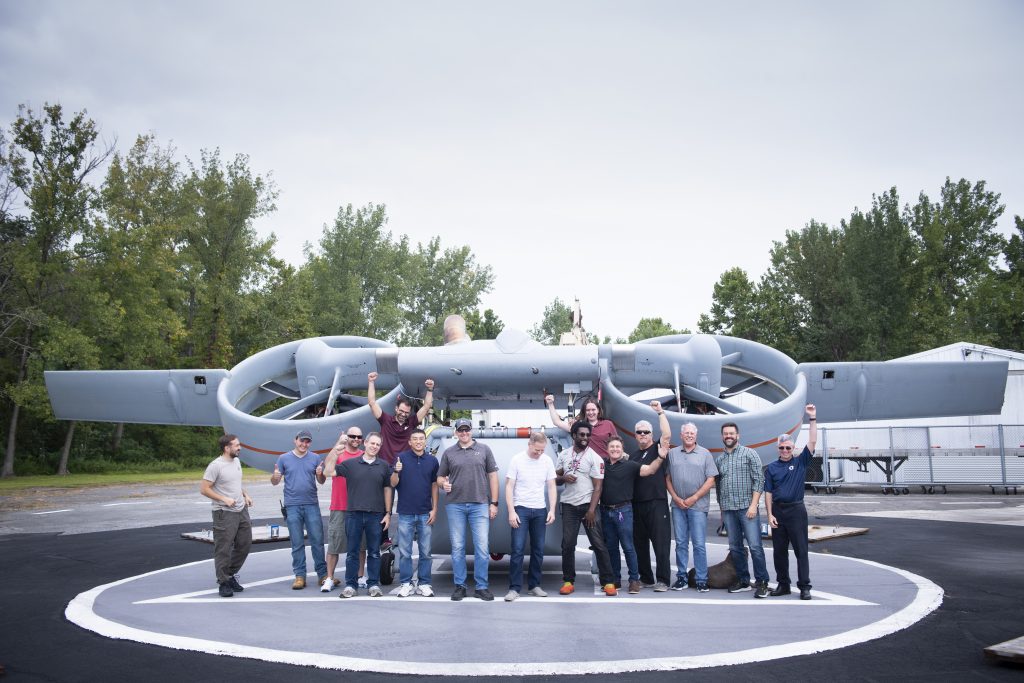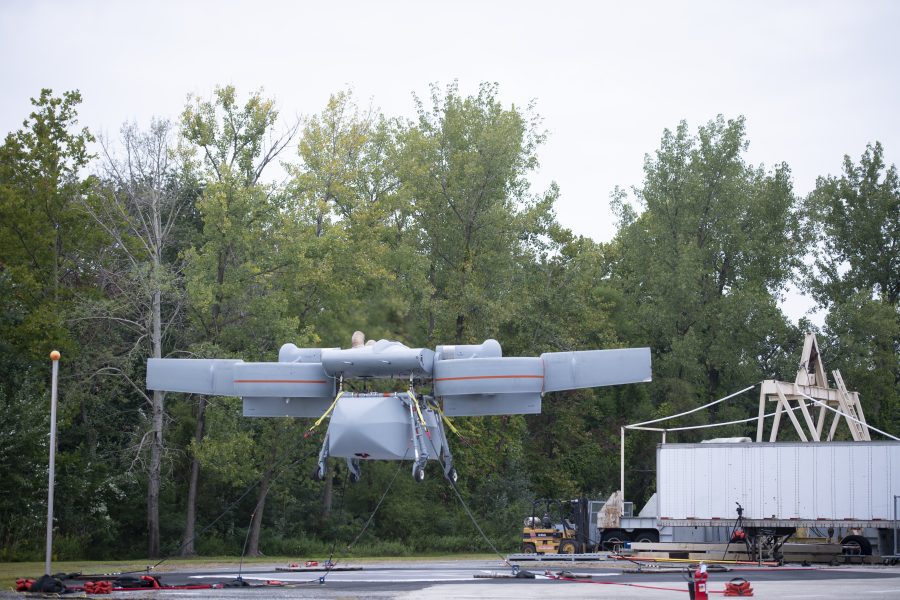Piasecki Aircraft, a firm known for its rotorcraft, conducted the first flight of its uncrewed tilt-duct vertical takeoff and landing (VTOL) aircraft Sept. 6, partially funded under a contract from AFWERX, the Air Force’s innovation arm.
The aircraft is envisioned as a possible autonomous evacuation and rescue craft or a battlefield resupply platform.
The two proof-of-concept demonstrations on the same day—the first for an autonomous tilt-duct aircraft—were flown with the aircraft tethered to the ground at Piasecki’s Essington, Pa. facilities. The first flight was flown with Piasecki’s Aerial Reconfigurable Embedded System Demonstration Vehicle (ARES–DV) alone and comprised a minute of hovering flight. The second flight mounted the Army’s Mobile Multiple Mission Module (M4), and again achieved a minute of hovering flight. This second flight demonstrated “the ability of its triplex fly-by-wire flight control system to sustain a stable hover in multiple configurations and a dynamic ground environment,” Piasecki said in a statement.
The current propulsion configuration is “two turbine engines feeding a combiner gear box (via driveshafts to right angle duct gearboxes, which drive rotor shafts),” a Piasecki spokesperson said. “Future configurations will use a propulsion system that best fits customer mission and needs.”
The Air Force has been looking at technology concepts that could extend the reach of its combat search and rescue aircraft and reduce the number of personnel exposed to fire while recovering downed Airmen close to or behind enemy lines. The tilt-duct aircraft is one such concept; it is being pursued under a November 2023, $37 million joint Air Force/Army Strategic Funding Initiative program. The Air Force element is being conducted under AFWERX.
In addition to ARES work, the contract called for Piasecki to demonstrate VTOL aircraft powered by hydrogen fuel cells.
The company said the Sept. 6 demonstrations are “the first step to demonstrate the potential of ARES to revolutionize autonomous airborne casualty evacuation [CASEVAC], cargo resupply, and provide other multimission capabilities in support of small, distributed combat units. The flight represents the beginning of the experimental flight test program. The company was not immediately able to expand on how many flights are expected or over what timeline. It also did not disclose the ARES’ takeoff weight or potential operational range.
“From this milestone, Piasecki will continue with flight envelope expansion to demonstrate performance hovering in and out of ground effect and low-speed maneuvering before moving into transition flight test points and eventually forward flight testing,” a company spokesperson said. “Upon completion of flight envelope expansion, the team will simulate a casualty evacuation (CASEVAC) mission with the M4 module.”
The tilt-duct concept allows operation from areas without the need for a runway and could work well with the Air Force’s Agile Combat Employment model of operating from large numbers of dispersed and austere locations, supported by small numbers of resupply/logistics aircraft.

The ARES-DV was initially developed by Lockheed Martin’s Skunk Works under a Defense Advanced Research Projects Agency program, but is now continuing development under Piasecki.
The ARES can be operated as uncrewed aerial system or with “an optional manned flight module,” Piasecki said. Its small landing footprint would enable “shipboard and expeditionary operations as well as provide embedded multimission C4 [command, control, communications and computers], ISR [intelligence, surveillance and reconnaissance] combat and logistics support to small, distributed combat forces operating over extended distances and in complex terrain.” The vehicle is meant to be “rapidly reconfigurable” with mission payload modules supported by a common flight module. This approach is intended to “reduce overall logistics footprint and cost.”
John Piasecki, CEO of the company, said the project has progressed “since its origins as a DARPA conceptual design through years of research and development … to mature the technology leading up to today’s landmark achievement,” which the company called an “aviation milestone.”
He said that after “successfully expanding the aircraft’s flight envelope, we will implement modifications to enable flight demonstration of a fully autonomous CASEVAC and logistics resupply capability.”
Barth Shenk, Air Force Research Laboratory program manager for ARES, said the aircraft “creates a new baseline for VTOL technology applied to heavy-payload, time-critical logistics crucial for dispersed operations.”
Honeywell Aerospace provides the ARES’ compact fly-by-wire integrated flight control system, which Piasecki said is “designed to fit into the limited space available on smaller aircraft.”
The system provides “safety-critical flight control capabilities typically found in much larger airliners and advanced fighter aircraft,” Piasecki said, enabling “precise handling and stability across a wide range of flight conditions.”
Piasecki acquired Lockheed’s Sikorsky Heliplex in Coatesville, Pa., in mid-2023, planning to convert the facility into a state-of-the art development and testing site for VTOL and uninhabited aircraft.
The Air Force has also pursued electric VTOL capabilities through its Agility Prime program, also through AFWERX, purchasing aircraft from Joby Aviation and Archer Aviation.


